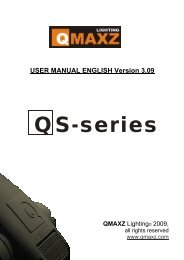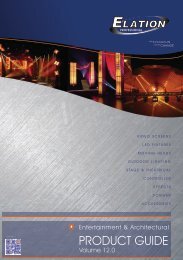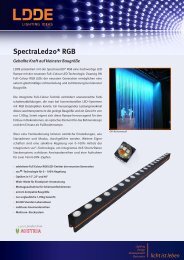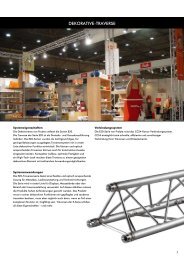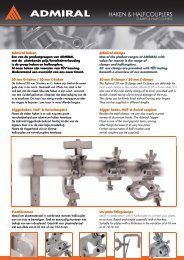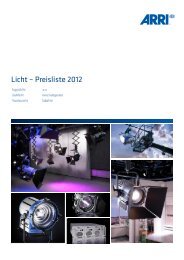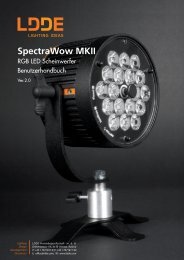Schneider Filters - Lightequip
Schneider Filters - Lightequip
Schneider Filters - Lightequip
You also want an ePaper? Increase the reach of your titles
YUMPU automatically turns print PDFs into web optimized ePapers that Google loves.
20<br />
C O L O R C O R R E C T I O N F I L T E R S<br />
Corals<br />
Application: To warm cool<br />
lighting situations such as overcast<br />
days and scenes in open shade.<br />
Varying strength <strong>Schneider</strong> Coral<br />
filters can be used to achieve the<br />
same degree of apparent warmth<br />
under different light conditions. This<br />
makes them particularly useful for<br />
maintaining consistent color balance<br />
throughout an entire day of<br />
shooting, or to create a sunset or<br />
dawn effect during the day. Can be<br />
used to under-correct a scene for an<br />
excessively blue look, adding drama<br />
and can also be used as warming<br />
filters for other dramatic effects.<br />
<strong>Schneider</strong> Coral filters may be<br />
used alone or in combination with<br />
other color correction filters.<br />
Cinematographers will often spice<br />
up a scene by combining an 85<br />
with a Coral #2 to add warmth.<br />
A complete set of <strong>Schneider</strong><br />
Coral filters offers the ability to<br />
control most outdoor lighting<br />
situations. Because <strong>Schneider</strong> filters<br />
are crafted with supreme consistency,<br />
same-number Corals can be swapped<br />
mid-shoot without discernible variation<br />
in color or effect.<br />
Sizes: Sizes: 4”x 4”, 4”x 5.65”<br />
(Panavision size), 5”x 5”, 5.65”x<br />
5.65”, 6.6”x 6.6” & 138mm Round<br />
Densities: 1/8, 1/4,<br />
1/2, 1 & 2<br />
Solid Corals come<br />
in 1/8, 1/4,<br />
1/2, 1, & 2.<br />
Magentas<br />
A <strong>Schneider</strong> Coral filter enhances orange foliage. Without a filter.<br />
A graduated Coral filter can enhance a sunset.<br />
Application: Correcting<br />
fluorescent lighting, music videos.<br />
<strong>Schneider</strong> graduated Color Correction<br />
filters are rated 1, 2, 3. All Magenta<br />
filters are matched exactly to Kodak<br />
Wratten standards.<br />
Sizes: 4”x 4”, 4”x 5.65” (Panavision<br />
size), 5”x 5”, 5.65”x 5.65”, 6.6”x 6.6”<br />
Densities: 10cc., 20cc., 30cc.<br />
Magenta Grads are available in Soft (shown)<br />
or Hard Edge in densities of 1,2, or 3.<br />
Sunset Series<br />
Classic Sunset<br />
Application: Works with a wide<br />
range of focal lengths to enhance an<br />
existing sunset or create the<br />
illusion of a flame<br />
orange sunset<br />
where none<br />
exists.<br />
<strong>Schneider</strong>’s Classic<br />
Sunset filter offers<br />
intense flame orange<br />
color that transitions to a soft gold<br />
gradient band across the center. The<br />
density at the darkest edge is 2<br />
stops. The other half of the filter is clear.<br />
Sizes: 4”x 4”, 4”x 5.65” (Panavision<br />
size), 5”x 5”, 5.65”x 5.65”, 6.6”x 6.6”<br />
Same shot through a <strong>Schneider</strong> Classic Sunset filter.<br />
Solid Magentas<br />
come in 10cc.,<br />
20cc., 30cc<br />
Photos courtesy of Reed Smoot, ASC<br />
CTB Color<br />
Correction<br />
Application: When working in<br />
HD, balances temperature from<br />
tungsten toward daylight.<br />
Many of today’s HD sensors are<br />
designed to work best in a daylight<br />
balanced lighting spectrum. With<br />
presets that compensate for tungsten<br />
light, this often raises significant<br />
noise in color channels under<br />
difficult low light conditions.<br />
<strong>Schneider</strong>’s CTB filter line balances<br />
color temperature from tungsten<br />
toward daylight in incremental<br />
steps. Users then have control to<br />
correct as much or as little of the<br />
exposure as desired. So they can<br />
color correct while maintaining low<br />
noise levels at minimal light level.<br />
The new CTB filter line has<br />
been designed to correspond to<br />
existing lighting color correction<br />
standards, offering a range of<br />
correction for most situations. Stop<br />
loss is 0.17 for the eighth, 0.24 for<br />
the quarter and 0.34 for the half.<br />
These filters maintain a high<br />
MTF (modulation transfer function).<br />
True Cut IR<br />
Application: IR contamination<br />
when photographing brightly<br />
sunlit scenes with digital cinema<br />
CMOS sensor cameras.<br />
<strong>Schneider</strong> has developed a family<br />
of IR filters to complement the<br />
demanding requirements of today’s<br />
High Definition cameras.<br />
High Definition camera arrays<br />
have a high sensitivity to light<br />
beyond the visible range. This can<br />
be beneficial in applications such as<br />
machine vision or surveillance but<br />
for most production this tends to be<br />
a problem due to unwanted color<br />
shifts in dark or black materials.<br />
<strong>Schneider</strong>’s True-Cut IR filter solutions<br />
eliminate this problem by limiting<br />
the light striking the CCD or CMOS<br />
imager to the visible spectrum.<br />
<strong>Schneider</strong>’s True-Cut IR filters<br />
include: IR True-Cut, IR True-Cut<br />
ND's & IR True-Cut True Pols.<br />
Sizes: 4”x 4”, 4”x 5.65” (Panavision<br />
size), 5”x5”, 5.65”x5.65”, 6.6”x 6.6”<br />
plus 77mm Rounds.<br />
Sizes: 4”x 4”, 4”x 5.65” (Panavision<br />
size), 5”x5”, 5.65”x5.65”, 6.6”x 6.6”<br />
plus 77mm Rounds.<br />
“The fixed sensitivity of the CMOS<br />
sensor makes it necessary to add<br />
many stops of ND compensation.<br />
ND filters effectively cut exposure so<br />
we can remain in the sweet spot of the lens, maintaining maximum<br />
clarity, and avoiding excess depth of field. But they do nothing to filter<br />
the unwanted effects of excess IR contamination, which can cause an<br />
overall lowering of image contrast — even making certain shades or<br />
textures of black appear as brown.<br />
<strong>Schneider</strong> Optics has developed the True-Cut 750 IR specifically to<br />
deal with this situation. If you want vibrant tones and rich deep shades<br />
of black when using a CMOS sensor to capture strongly lit daylight<br />
scenes, I strongly suggest using this new filter.”<br />
James Mathers, Director of Photography<br />
21



